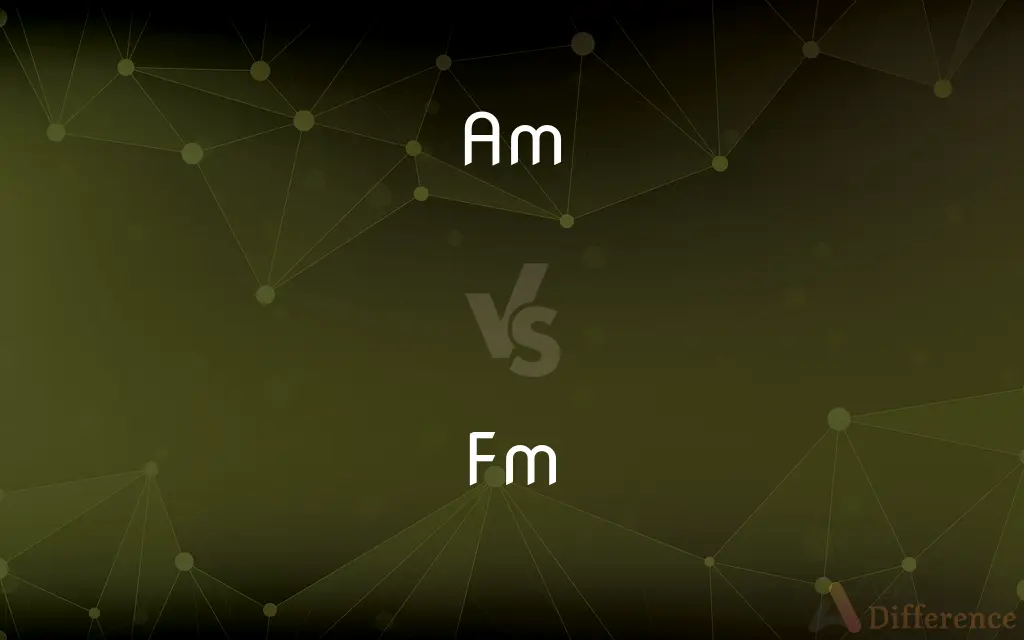AM vs. FM — What's the Difference?
By Tayyaba Rehman — Updated on September 23, 2023
AM stands for "Amplitude Modulation" and varies signal strength, while FM means "Frequency Modulation" and varies signal frequency. Both are radio broadcasting methods.

Difference Between AM and FM
Table of Contents
ADVERTISEMENT
Key Differences
AM, or Amplitude Modulation, and FM, or Frequency Modulation, are two fundamental methods of transmitting information via radio waves. AM modifies the amplitude (or height) of the signal to convey information. FM, in contrast, adjusts the frequency (or spacing) of the signal.
In the realm of radio broadcasting, AM is older than FM. With AM, the strength of the radio waves is altered to carry sound. FM, however, changes the frequency of waves to transmit sound, resulting in clearer audio quality. The clarity of FM is why music stations primarily use it, while talk radio often resides on AM.
The AM band is susceptible to interference, including weather and physical obstacles. FM is less prone to such disturbances but can be affected by distance and geographical features. This means that AM signals can often travel further than FM, especially at night.
While AM is prevalent for its long-range capabilities, FM is cherished for its sound quality. With stereo broadcasting capabilities, FM delivers a richer listening experience. AM, though capable of covering vast distances, often provides a more static-filled sound.
Comparison Chart
Meaning
Amplitude Modulation.
Frequency Modulation.
ADVERTISEMENT
How it transmits sound
Varies signal strength (amplitude).
Varies signal frequency.
Susceptibility to interference
More prone to interference.
Less prone, but affected by distance/obstacles.
Common usage
Talk radio, news.
Music stations, clearer audio quality.
Range
Can travel longer distances.
Limited by geography and distance.
Compare with Definitions
Am
Commonly used for talk radio and news.
I tuned into the AM frequency for the baseball commentary.
Fm
A method of transmitting radio signals by varying frequency.
The FM station played the latest hits all day.
Am
Older radio broadcasting technique.
Many classic radio shows were broadcasted using AM.
Fm
Offers high audio clarity and quality.
FM radio is my go-to for music because of its clear sound.
Am
Prone to interference from obstacles and weather.
The storm caused static on the AM channels.
Fm
Less prone to static interference.
The FM channels were clear, despite the storm outside.
Am
Covers vast distances, especially during the night.
I could pick up the AM station even from another state at night.
Fm
Popular for music and stereo broadcasts.
My favorite rock bands always sound best on FM.
Am
A method of transmitting radio signals by varying amplitude.
The AM station broadcasted news updates throughout the day.
Fm
Limited range compared to AM.
The FM station fades when I drive out of town.
Am
First person singular present indicative of be.
Fm
(stenoscript) from
Am
Inflection of be
Fm
The symbol for the element Fermium.
Am
The first person singular of the verb be, in the indicative mode, present tense. See Be.
God said unto Moses, I am that am.
Fm
The chemical symbol for Fermium, a transuranic element.
Am
A radioactive transuranic metallic element; discovered by bombarding uranium with helium atoms
Fm
A method of transmitting radio signals by modulating the frequency of the carrier wave; - opposed to AM (amplitude modulation), in which the signal modulates the amplitude, rather than the frequency of the carrier wave.
Am
A master's degree in arts and sciences
Fm
Modulation of the frequency of the (radio) carrier wave
Am
Modulation of the amplitude of the (radio) carrier wave
Fm
A radioactive transuranic metallic element produced by bombarding plutonium with neutrons
Common Curiosities
Why is AM prone to interference?
AM alters the signal's strength, making it susceptible to disruptions.
Do all radios receive both AM and FM?
Most modern radios can receive both, but always check the device specifications.
What does AM stand for?
AM stands for Amplitude Modulation.
Are there digital versions of AM and FM?
Yes, there are digital broadcasting methods for both AM and FM, offering even clearer sound.
What is the primary characteristic of FM?
FM modulates signal frequency for transmission.
Is FM a newer technology than AM?
Yes, FM broadcasting came after AM.
AM or FM?
FM typically offers clearer sound quality.
Can AM broadcast in stereo?
While possible, stereo broadcasts are more common with FM.
Why do some AM stations become clearer at night?
Radio wave behaviors change at night, allowing AM signals to travel further.
Which has a longer broadcast range?
AM generally has a longer broadcast range, especially at night.
Is FM safer than AM?
Both are safe for listening; the difference lies in transmission techniques.
Can FM signals bounce off obstacles?
Yes, but they're more affected by distance and geographical features.
Why do I hear more static on AM than FM?
AM is more susceptible to interference, causing static.
Share Your Discovery

Previous Comparison
Scrum vs. Waterfall
Next Comparison
Hinduism vs. IslamAuthor Spotlight
Written by
Tayyaba RehmanTayyaba Rehman is a distinguished writer, currently serving as a primary contributor to askdifference.com. As a researcher in semantics and etymology, Tayyaba's passion for the complexity of languages and their distinctions has found a perfect home on the platform. Tayyaba delves into the intricacies of language, distinguishing between commonly confused words and phrases, thereby providing clarity for readers worldwide.













































